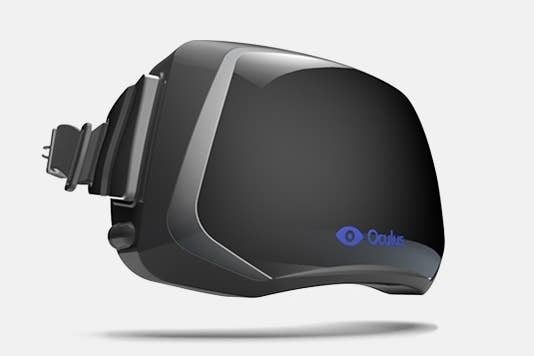"No one cares about greater visual fidelity anymore" - Oculus' David De Martini
Former EA exec signs on as VR firm's head of worldwide publishing, lays out plan to line up content for launch
Oculus VR has added another seasoned veteran to its growing ranks, as the Rift maker today announced David De Martini as its new head of worldwide publishing. De Martini spent the last 15 years as a senior vice president at EA, where at different times he oversaw EA Origin, the EA Partners program, and its Redwood Shores studio. Speaking with GamesIndustry International this week, De Martini said he hadn't expected to add Oculus to the resume when he finally parted ways with EA a couple months ago.
"I was ready to potentially retire to the golf course, and this was just so ground-breaking that it took me out of playing golf three days a week," De Martini said. "The potential was just so large that it was really something I'd been searching for at least the last five years within EA. It's the most exciting thing I've been a part of since at least Rock Band at EA."
De Martini actually met with Oculus on a reference from his old boss, John Riccitiello. The former EA CEO told De Martini first that he had to see the technology in action, and second, that he was an ideal fit to bring developers on board the platform.
"[AAA publishers'] core audience, hardcore gamers, are so behind this platform that they have to respond to the cry from the community to get great content on the platform."
David De Martini
"I took a flight, came down here and experienced the device, and within about 30 seconds, I was sold not only on the potential of this device, but what this device actually can do," De Martini said.
Thoroughly convinced, De Martini signed on with Oculus, and now says he's focused on introducing the Rift's capabilities to developers large and small to see what they can do with it. While the company already has support from big names like Valve, CCP, Unity, and Epic Games, De Martini said he expects them to have plenty of company as Oculus gets closer to launch.
"I think what you're going to see is with last week's announcement on continued investment, every piece of news that comes out of this headquarters and comes from this team adds more certainty that this thing is launching in the foreseeable future," De Martini said. "And as that certainty demonstrates itself, I think you're going to see the EAs of the world, the Activisions of the world, along with all the other independent developers jumping on board. There's just so much momentum. Their core audience, hardcore gamers, are so behind this platform that they have to respond to the cry from the community to get great content on the platform."
Oculus vice president of product Nate Mitchell said it's not just third-party publishers that people want on the Rift. While CEO Palmer Luckey is on record as saying the current hardware cycles for consoles like Xbox One and PlayStation 4 are "too limited" for what the company wants to do, Mitchell suggested they could work something out after all.
"I think there's a huge demand for Oculus on the consoles because frankly, the gaming community is there," Mitchell said. "There's a huge PC gamer base at Oculus, but there's also an enormous console base. So many gamers out there own consoles; of course it makes sense that we'd want to have the Rift working on those machines. I think there's a ton of enthusiasm from the community to get the Rift on consoles. We'll see where we end up."
"I think what a lot of gamers are going to be blown away by is five years from now when they're playing whatever it is on Rift 2.0 on their PC."
Nate Mitchell
The biggest problem Mitchell saw was that the VR technology is advancing so quickly that the most immersive experiences will be possible on PCs that are advancing astride, rather than console hardware that is essentially fixed at the beginning of a hardware cycle.
"I think what a lot of gamers are going to be blown away by is five years from now when they're playing whatever it is on Rift 2.0 on their PC," Mitchell said. "It's going to be an awe-inspiring experience and something special. That's why we're focused there."
Despite the buzz surrounding the Rift, De Martini doesn't expect his job lining up content to be easy. For one thing, he'll be trying to convince people running businesses to devote resources to a platform with no installed base coming from a company that hasn't actually shipped a product to consumers yet.
"We have exactly zero production units sold in right now," De Martini said. "So they look at that and ask how many are you going to have? When are you going to ship? How many are you going to ship? And we point them to directional answers. And developers like certainty. They like specific answers."
The big things De Martini has working in his favor these days are the technology itself, and the word-of-mouth it's been producing. De Martini acknowledges that "virtual reality" has a stigma attached to thanks to previous VR fads in gaming that never took off, but he's confident the hands-on experience with Rift will answer any questions about the quality of the product.
He likens the difference between the VR of yesterday and today to the difference between mobile phone 15 years ago and now. The form factor is smaller, the number of things it can do has grown, the tech has improved in every aspect, and the experience is completely different now from what it was. And in an era where people talk about the diminishing returns of brute hardware strength, that novel experience will be key, De Martini believes.
"People are so tired of the last 15 years of the game industry, hearing about 'greater visual fidelity,'" De Martini said. "No one cares about greater visual fidelity anymore. It's already good enough. We don't need things to look even better; we need the experience to fundamentally change, and the Oculus platform is a fundamental change to how people will experience games."









